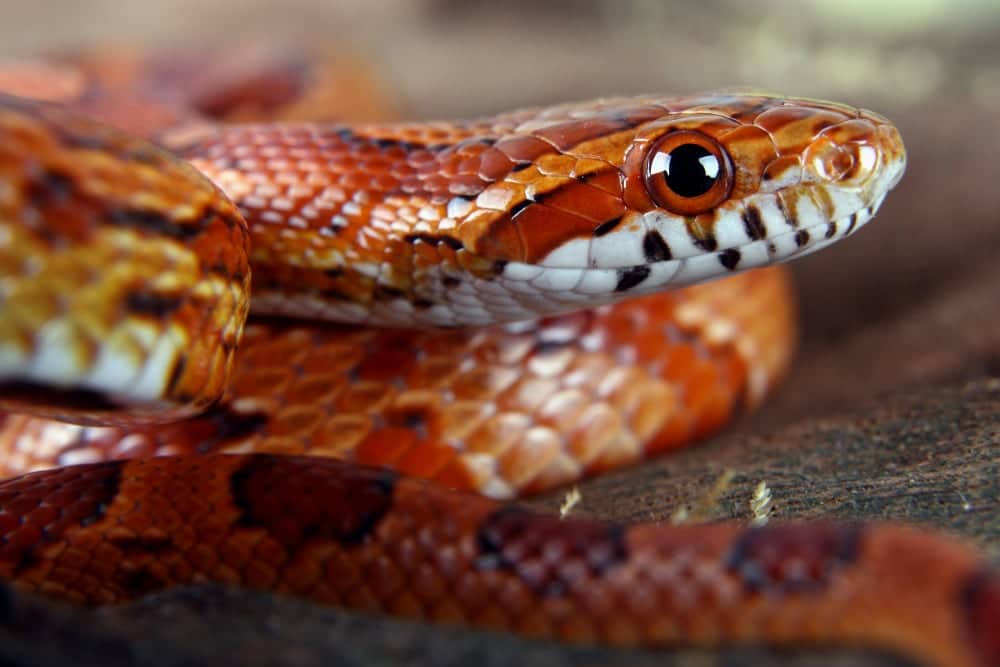Here we present you five beginner friendly snakes, in no particular order.
We often get questions about what is an ideal beginner pet snake for those new to the hobby. Beginner meaning fairly easy to care for with not a lot of requirements other than good husbandry and attention to detail. Of all the reptiles available in the hobby, snakes seem to be the most popular. Go to any reptile show, and the majority of the animals available are of the legless kind. Snakes can make great pets. They can be secretive or outgoing, depending on the individual snake and the species, and some of them are easy to care for. Here we present you five beginner friendly snakes, in no particular order, for those new to the hobby, or for those who wish to add a new animal to your collection that is fairly easy to keep.
5 Great Pet Snakes
- Corn Snake
- California Kingsnake
- Rosy Boa
- Gopher Snake
- Ball Python
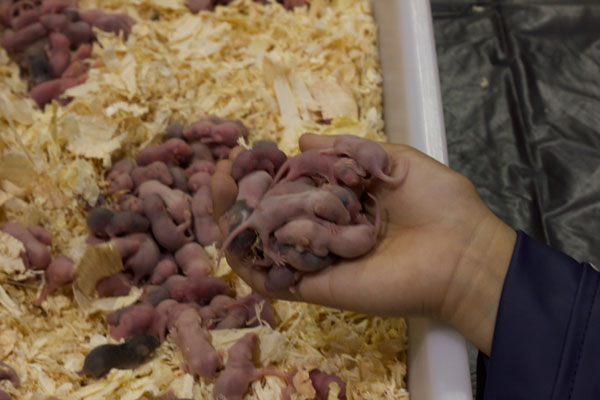
john virata
Snake hatchlings can be started on pinkies.
Corn Snake
Before the ball python captured the imagination of snake lovers, the corn snake (Pantherophis guttata) was the most popular pet snake available. Fairly docile, easy to handle and care for, what is not to like about this North American native? Corn snakes are still one of the most popular pet snakes because of their demeanor, availability, and their color combinations. They don’t grow too big, and if you wish to breed them, are very easy to breed.
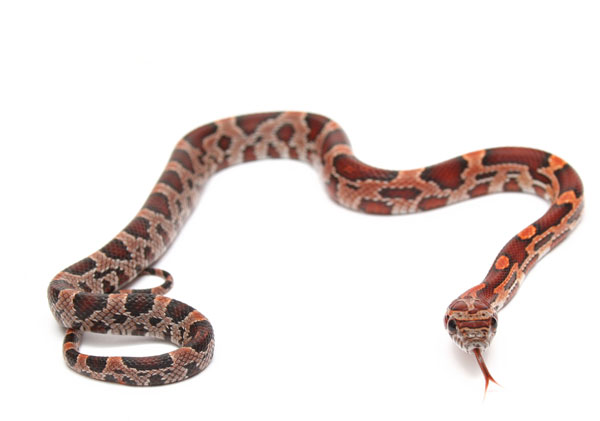
gina cioli/I-5 Studio
Okeetee corn snake.
Corn snake hatchlings average around $25-40 depending on where you buy them and their color variation. You can keep a hatchling in a 20-gallon enclosure for two to three years. After this, you should upgrade the enclosures to a minimum 50 gallon equivalent and larger enclosure. Make sure it has a screened top, an under tank heat pad attached to a thermostat, a ceramic water bowl, two hides (a cave and a half log are fine), some driftwood for climbing, and aspen substrate. No special lighting is required and when I feed them, I pull them out and place them in their own separate shoebox where they both get a frozen/thawed rat pup or F/T mice. They can live for a long time.
Read the Corn Snake Care Sheet here.
California Kingsnake
California kingsnakes (Lampropeltis getula californiae) are considered kings because of their capability to kill and eat rattlesnakes and other snakes. Here in Southern California, the California kingsnake is popular both in the trade and to observe in the wild. They are also super popular beginner snakes, though they can be a bit nippy if not handled often enough. In the wild, these snakes are fairly opportunistic feeders, eagerly hunting down and eating other snakes, including venomous snakes, small rodents, lizards, birds, and even bird eggs.
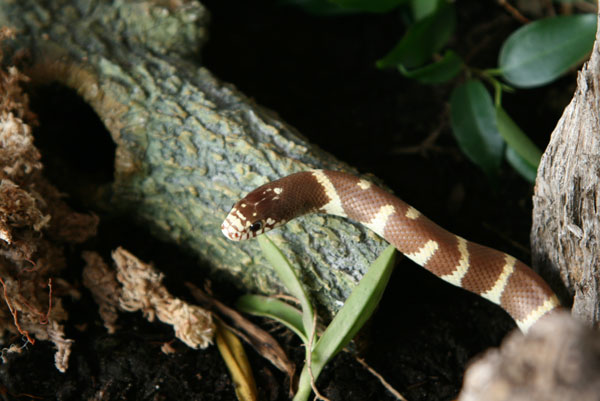
elvis+santana/thinkstock
Kingsnakes don’t grow too large, averaging 3 to 4 feet in length.
Kingsnakes don’t grow too large, averaging 3 to 4 feet in length. You can house one in a 40 gallon enclosure with a screened top, a hide and suitable substrate. The larger the enclosure, the better for the snake. An under tank heat pad attached to a thermostat optimized for your tank size is necessary to help the snake thermoregulate and aid in digestion. The water bowl should be large enough for the snake to soak in, and heavy enough so the snake doesn’t tip it over. No special lighting is required to keep this species. Feed hatchling kingsnakes appropriately sized pinky mice (no wider than the girth of the snake) and as they grow, your feeders should grow with them (Pinkies, then fuzzies, hoppers, then small mice, and then adult mice, depending on how big the snake gets). Adult snakes can be fed frozen thawed mice or even frozen thawed rat pups. You can purchase a baby kingsnake for about $50 give or take, and that $50 can buy you anything from an aberrant black and white kingsnake to a baby albino kingsnake (in the upper $50 range). Other than coloration, they are all Lampropeltis getula californiae.
Read the California Kingsnake Care Sheet here.
Rosy Boa
The rosy boa (Lichanura trivirgata), though not as popular as the corn snake or the California kingsnake, is still a popular pet snake in the hobby. Fairly docile, the rosy boa doesn’t get too large, growing to about 4 feet in length when fully grown, though average sizes are 2 to 3 feet in length. The rosy boa can be purchased for around $30-40 as hatchlings at reptile shows, reptile stores, and on the Internet. They are not typically found in the big box retail pet stores, where you can readily find corn snakes and ball pythons. The rosy boa is a long lived snake, capable of living 25+ years or more. My best friend growing up had a rosy boa that lived 16 years.
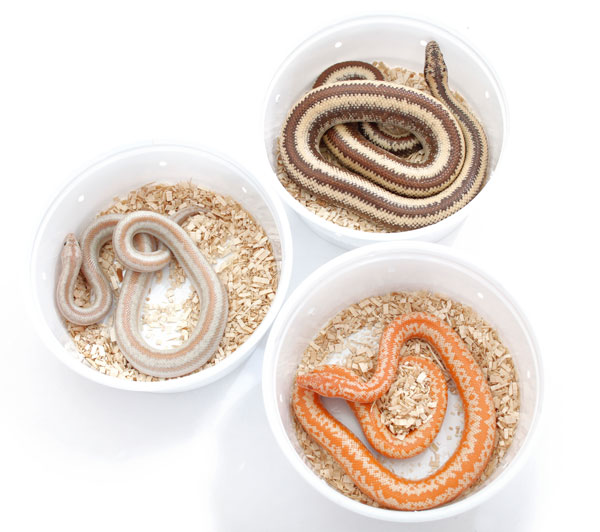
gina cioli/I-5 Studio. Snakes courtesy randy wright
Like ball pythons and corn snakes, rosy boas come a a variety of colors.
The rosy boa enclosure, as with all snake enclosures, should be escape proof. Also, because rosy boas are often looking for an escape route, a screened top is not recommended, as they can abrade their noses. A 40-gallon tall enclosure is ideal for adult rosy boas while hatchlings can be started in small shoeboxes or other similarly sized enclosure. For substrate, aspen bedding is ideal. About two inches of substrate will enable your rosy boa to burrow. You can spot clean the enclosure as you come across wet spots and snake poop, and change out the substrate every other month or so. As with the other snakes on the list, special lighting is not necessary, but a heat source is. The best heat source is and under tank heat pad or tape, attached to a thermostat, on one side of the enclosure so the snake can thermoregulate. This also aids in digestion. Feed your rosy boa an appropriately sized frozen thawed mouse two to four times a month during the spring and less during the winter.
Read the Rosy Boa Care Sheet here.
Gopher Snake
Gopher snakes (Pituophis spp.) are probably one of the best kept secrets in the hobby. They come in a variety of morphs, are fairly easy to find for sale, and their prices stay very reasonable. Gopher snake pricing starts at around $50. You can find them cheaper at local reptile shows. The gopher snake grows to about 3 to 6 feet in length, with an average length of 4 to 5 feet. They are a heavy bodied snake that can live 15+ years in captivity.
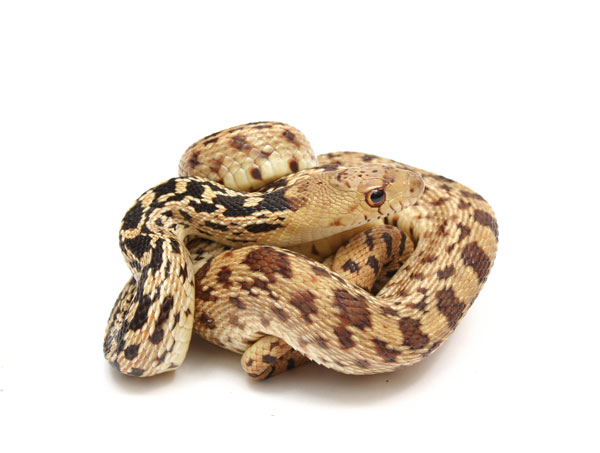
gina cioli/I-5 Studio
Gopher snakes average 3-5 feet in length.
You can start these snakes in a 20-gallon long enclosure and move up to 50 gallons as adults, with 4 foot long enclosures the optimum size for adult gopher snakes. For substrate, about two to three inches of aspen wood bedding is ideal as this allows the snake to burrow. Special lighting is not necessary for the health of a gopher snake. Keep a single heat source on one side of the enclosure so the gopher snake can thermoregulate as they prefer temperatures from the mid-70s to the mid-80s. Keep a water bowl that is large enough for them to soak in full of non-chlorinated fresh water. You can feed your hatchling gopher snake appropriately sized pinky mice, that is the same size or just slightly larger than the widest part of the snake, while full grown adults can be fed frozen/thawed rats.
Read the Gopher Snake Care Sheet here.
Ball Python
The ball python (Python regius) is currently the most popular pet snake, made so primarily by the crazy amount of morphs that are available as well as their generally very shy demeanor. With proper care techniques, it is not too difficult to keep a ball python. Unlike most of the other snakes on the list, the ball python needs some humidity in its cage as they are native to central and western Africa. The snake is not a large python but is heavy bodied. The female ball python grows to about 3 to 5 feet in length while the male is smaller at around 2 to 3 feet in length. Your size may vary. Ball pythons, like rosy boas, are long lived snakes, with some living more than 30 years in captivity. You can keep ball pythons in enclosures around 3 feet in length. Avoid screen tops if you can as a screen top makes it hard to keep the humidity up in the enclosure. A 40-gallon enclosure works well for hatchlings. Move them up to a 4’x2’x’2′ enclosure after 3 to 5 years. A hide box is essential for the well being of this species. As it is generally shy, you should keep a hide box on both sides of its enclosure. Water bowls should be large enough to soak in. Heavy bowls, such as ceramic bowls are ideal over plastic bowls.
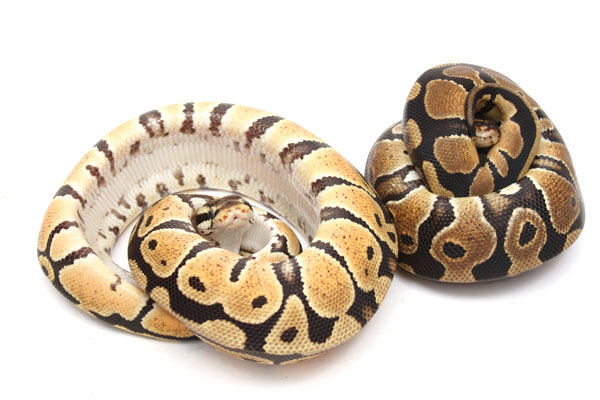
gina cioli/I-5 Studio
A pastel ball and a normal ball python.
Normal ball pythons start at around $30 at most reptile shows. Pet stores sell them around that price as well. When you get into the morphs, the sky is the limit. While the price of certain morphs have come down considerably since their ridiculous highs, there are still some pricey ball pythons out there. The good news is that reptile shows are chock full of breeders selling all manner of ball python morph, and at these shows, its a buyer’s market. It all depends on how much you wish to spend. I myself prefer the normal ball python. Its normal coloration is striking in itself.
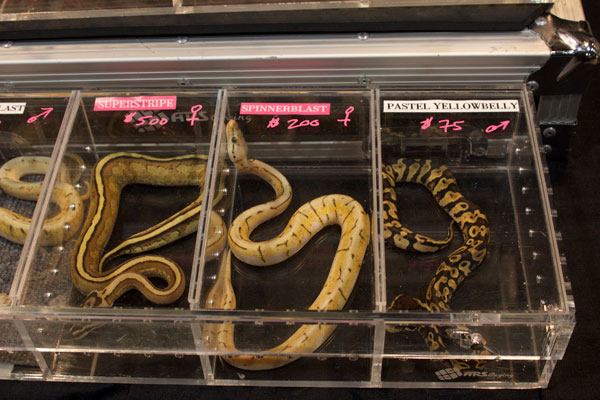
john virata
Ball pythons are available in a range of morphs with price points to match.
Of all the snakes on this list, the ball python sits right at the edge of a good beginner snake. It has more specific care requirements than the others. In addition to its care requirements, the ball python often stops eating, or going “off feed” for whatever reason at any time of the year. One of the most popular questions with regard to ball pythons is “why my ball python won’t eat.” For most circumstances, this is a perfectly normal part of a ball python being a ball python. There is no rhyme nor reason why they stop eating, they just do. This can occur for months at a time. And for the most part, if your ball python looks healthy, there is no cause for alarm. If it starts to look thin or emaciated, then you have a problem and you should visit a veterinarian immediately.
Read the Ball Python Care Sheet here.
John B. Virata keeps a western hognose snake, a ball python, two corn snakes, a king snake, and two leopard geckos. His first snake, a California kingsnake, was purchased at the Pet Place in Westminster, CA for $5. His first pet reptile was a green anole that arrived in a small box via mail order. Follow him on Twitter @johnvirata

